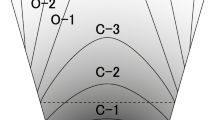Abstract
Background
Gastric cancer develops after successful H. pylori eradication in patients with severe atrophic gastritis. We classified atrophic and non-atrophic mucosa of gastric body using magnifying NBI endoscopy in patients after successful H. pylori eradication.
Materials and Methods
One hundred and twenty-five patients after successful H. pylori eradication (median period after eradication: 36 months) were enrolled. Magnifying NBI patterns in the uninvolved gastric body were divided into the following: restored-small, round pits, accompanied with honeycomb-like subepithelial capillary networks; atrophic-well-demarcated oval or tubulovillous pits with clearly visible coiled or wavy vessels. The subjects were also classified into the three types: Grade 0—restored pattern is shown in all or almost the entire area of gastric body; Grade 1—mixture of restored and atrophic pattern, there is a considerable portion of the atrophic area in the lesser curvature; Grade 2—atrophic pattern is shown in all or almost the entire area of the gastric body.
Results
Sensitivity and specificity for atrophic type for detection of histological intestinal metaplasia were 95.9 and 98.3%, respectively. No association was observed between the prevalence of Grades 0, 1 and 2 and duration after eradication, while grades 1 and 2 were significantly frequent in gastric cancer patients diagnosed both before (27/35: 77%) and after (23/31: 74%) eradication, compared to the cancer-free subjects (15/59: 25%) (P < 0.001). The grades 1 and 2 were also common in patients who underwent H. pylori eradication for gastric ulcer.
Conclusions
Magnifying the NBI pattern well correlates with pathological status of gastric mucosa after H. pylori eradication and may predict gastric cancer occurrence.



Similar content being viewed by others
References
Parsonnet J, Friedman GD, Vandersteen DP, et al. Helicobacter pylori infection and the risk of gastric carcinoma. N Engl J Med. 1991;325:1127–1131.
Huang JQ, Sridhar S, Chen Y, et al. Meta-analysis of the relationship between Helicobacter pylori seropositivity and gastric cancer. Gastroenterology. 1998;114:1169–1179.
Uemura N, Okamoto S, Yamamoto S, et al. Helicobacter pylori infection and the development of gastric cancer. N Engl J Med. 2001;345:784–789.
Watanabe T, Tada M, Nagai H, et al. Helicobacter pylori infection induces gastric cancer in Mongolian gerbils. Gastroenterology. 1998;115:642–648.
Shimizu N, Ikehara Y, Inada K, et al. Eradication diminishes enhancing effects of Helicobacter pylori infection on glandular stomach carcinogenesis in Mongolian gerbils. Cancer Res. 2000;60:1512–1514.
Fukase K, Kato M, Kikuchi S, et al. Effect of eradication of Helicobacter pylori on incidence of metachronous gastric carcinoma after endoscopic resection of early gastric cancer: an open-label, randomized controlled trial. Lancet. 2008;372:392–397.
Kamada T, Hata J, Sugiu K, et al. Clinical features of gastric cancer discovered after successful eradication of Helicobacter pylori: results from a 9-year prospective follow-up study in Japan. Aliment Pharmacol Ther. 2005;21:1121–1126.
Yamamoto K, Kato M, Takahashi M, et al. Clinicopathological analysis of early-stage gastric cancers detected after successful eradication of Helicobacter pylori. Helicobacter. 2011;16:210–216.
Hanaoka N, Uedo N, Shiotani A, et al. Autofluorescence imaging for predicting development of metachronous gastric cancer after Helicobacter pylori eradication. J Gastroenterol Hepatol. 2010;25:1844–1849.
Goda K, Tajiri H, Ikegami M, et al. Usefulness of magnifying endoscopy with narrow band imaging for the detection of specialized intestinal metaplasia in columnar-lined esophagus and Barrett’s adenocarcinoma. Gastrointest Endosc. 2007;65:36–46.
Machida H, Sano Y, Hamamoto Y, et al. Narrow-band imaging in the diagnosis of colorectal mucosal lesions: a pilot study. Endoscopy. 2004;36:1094–1098.
Ezoe Y, Muto M, Uedo N, et al. Magnifying narrowband imaging is more accurate than conventional white-light imaging in diagnosis of gastric mucosal cancer. Gastroenterology. 2011;141:2017–2025.e3.
Okubo M, Tahara T, Shibata T, et al. Changes in gastric mucosal patterns seen by magnifying NBI during H. pylori eradication. J Gastroenterol. 2011;46:175–182.
Tahara T, Shibata T, Nakamura M, et al. Gastric mucosal pattern by using magnifying narrow-band imaging endoscopy clearly distinguishes histological and serological severity of chronic gastritis. Gastrointest Endosc. 2009;70:246–253.
Kimura K, Takemoto T. An endoscopic recognition of the atrophic border and its significance in chronic gastritis. Endoscopy. 1973;5:21–26.
Sipponen P, Kekki M, Haapakoski J, et al. Gastric cancer risk in chronic gastritis. Statistical calculations of cross-sectional data. Int J Cancer. 1985;35:173–177.
Kokkola A, Kosunen TU, Puolakkainen P, et al. Spontaneous disappearance of Helicobacter pylori antibodies in patients with advanced atrophic corpus gastritis. APMIS. 2003;111:619–624.
Correa P. Helicobacter pylori and gastric carcinogenesis. Am J Surg Pathol. 1995;19:S37–S43.
Author information
Authors and Affiliations
Corresponding author
Ethics declarations
Conflict of interest
The authors declare that they have no conflicts of interest.
Rights and permissions
About this article
Cite this article
Tahara, T., Tahara, S., Tuskamoto, T. et al. Magnifying NBI Patterns of Gastric Mucosa After Helicobacter pylori Eradication and Its Potential Link to the Gastric Cancer Risk. Dig Dis Sci 62, 2421–2427 (2017). https://doi.org/10.1007/s10620-017-4676-x
Received:
Accepted:
Published:
Issue Date:
DOI: https://doi.org/10.1007/s10620-017-4676-x




